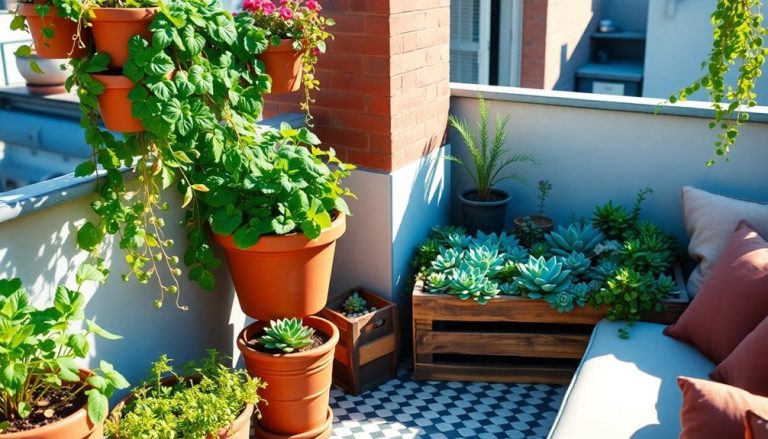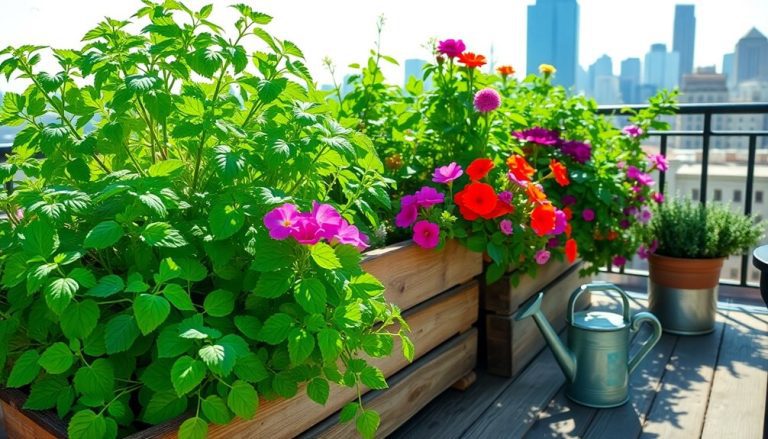Container gardening is ideal for maximizing green space in limited areas. You can easily arrange pots on balconies or patios to catch the sun. With containers, you control the soil quality and can reduce pests by managing plants in one spot. The mobility of pots lets you adjust your garden as needed, while vertical options make the most of your height. You'll find that many herbs and vegetables thrive in containers without all the fuss of traditional gardening. Curious about the best plants and tips to get started? You'll discover plenty more to elevate your gardening experience.
Key Takeaways
- Container gardening maximizes growing areas in limited spaces, such as balconies and patios, allowing for more plants in smaller footprints.
- Easy mobility of containers enables optimal sunlight exposure and flexible visual arrangements, adapting to changing light conditions.
- It provides complete control over soil quality and nutrient selection, ensuring healthy plant growth tailored to specific needs.
- Pest management is simplified as plants are contained, making it easier to monitor and treat infestations quickly.
- Reduced maintenance time is achieved with less weeding, making container gardening a low-effort option for busy gardeners.
Benefits of Container Gardening
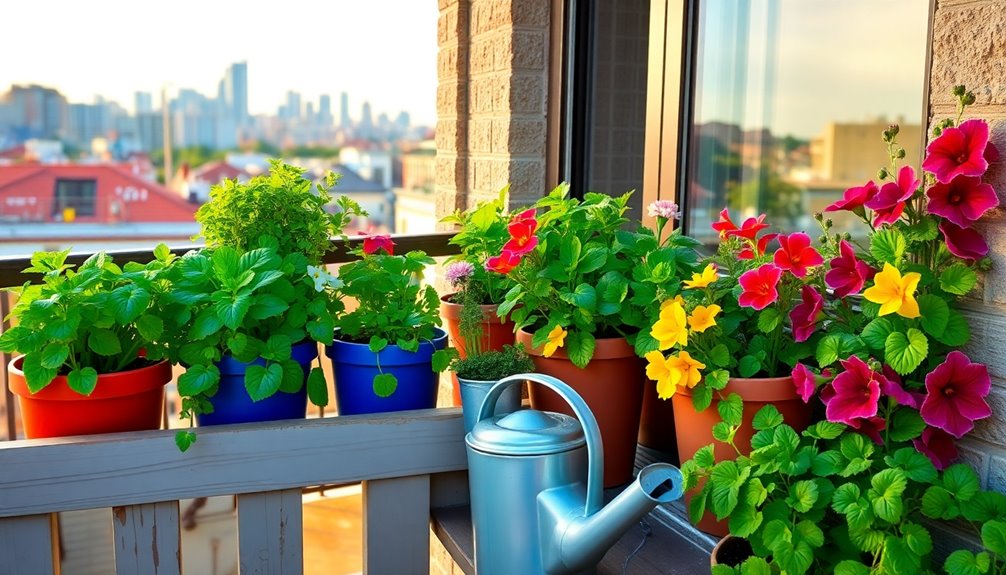
Container gardening offers a world of benefits, especially for those with limited space. You can transform any small area, like a balcony or patio, into a flourishing green oasis. Not only does it maximize your growing area, but it also allows for easy mobility; you can rearrange your plants to catch the best sunlight or create a visually appealing setup. Additionally, using grow bags can further enhance your container gardening experience by improving aeration and drainage.
One of the biggest advantages is that container gardening gives you control over soil quality. You can choose the right potting mix for your plants, ensuring they receive optimal nutrients. Additionally, our complete kits provide everything you need to start your herb garden, including seeds and pots.
Plus, since containers typically drain better than traditional garden beds, you'll help prevent root rot and overwatering.
Another perk is the ease of pest management. With your plants contained, it's simpler to monitor and treat any issues without them spreading to nearby plants.
You'll also save time on maintenance since containers require less weeding than traditional gardens.
Lastly, container gardening can enhance your lifestyle. Growing your own herbs, vegetables, or flowers right outside your door not only beautifies your space but also offers fresh produce at your fingertips, promoting healthier eating habits.
Ideal Plants for Containers
Choosing the right plants is key to a successful container garden. You'll want to select plants that thrive in smaller spaces and adapt well to growing in pots. Start with herbs like basil, parsley, and chives. They're compact, and you can snip fresh leaves for cooking right from your container. Consider creating a lush indoor herb garden to enjoy fresh flavors all year round.
If you prefer flowers, consider petunias, marigolds, or geraniums. These colorful blooms not only brighten up your space but also attract beneficial pollinators.
For vegetables, cherry tomatoes, peppers, and lettuce are excellent choices. They grow well in containers and provide a bountiful harvest.
Don't forget about perennials like sedum, lavender, and ornamental grasses. These plants can add texture and interest throughout the seasons, making your container garden visually appealing year-round.
When selecting plants, also consider their sunlight and water needs. Grouping plants with similar requirements can simplify care and maintenance. Additionally, keep in mind that succulent plants are also great options for container gardening due to their low water needs and resilience.
Additionally, think about vertical gardening options—plants like sweet peas or climbing beans can maximize your space.
With the right choices, you can create a thriving container garden that enhances your limited area beautifully.
Space Optimization Techniques
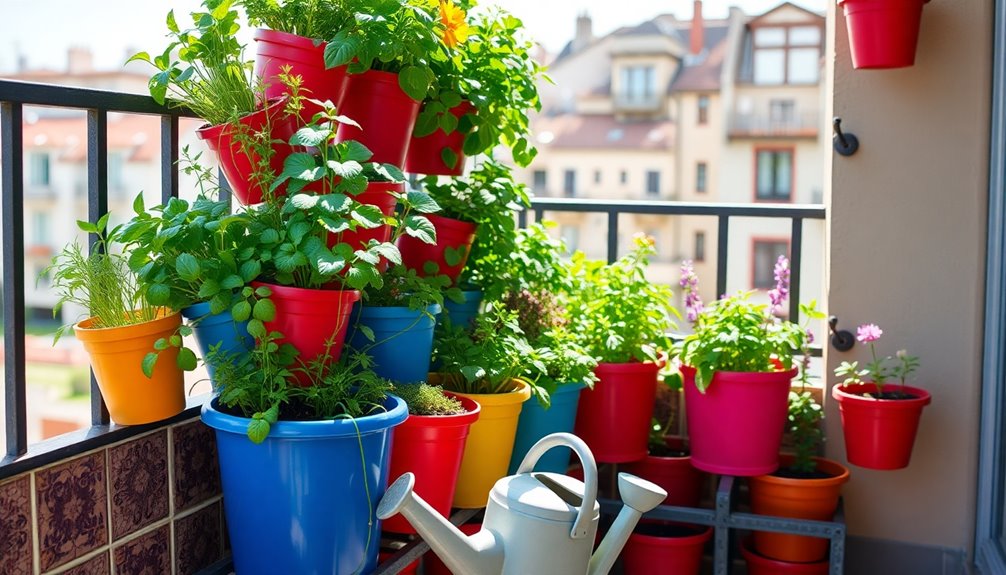
When you're working with limited space, optimizing every inch of your container garden is essential. Here are some effective techniques to make the most of what you have.
First, consider vertical gardening. Using wall-mounted planters or stacking pots allows you to grow more plants without taking up too much floor space. Also, think about companion planting. Pairing plants that grow well together can maximize your yield and minimize space.
You can also use the following table to identify space-saving strategies:
| Technique | Description |
|---|---|
| Vertical Gardening | Utilize walls or shelves for planting. |
| Companion Planting | Grow plants together that benefit each other. |
| Multi-Purpose Containers | Choose containers that can double as decor. |
Additionally, incorporating vertical garden kits can provide even more options for creating beautiful and functional vertical gardens. Lastly, choose containers wisely. Opt for larger pots that can accommodate multiple plants, or use self-watering containers to reduce maintenance time. By implementing these space optimization techniques, you'll not only enhance your gardening experience, but you'll also create a thriving garden in even the tiniest of areas.
Soil and Fertilization Tips
A good foundation is crucial for your container garden's success, and that starts with the right soil and fertilization. Use a high-quality potting mix specifically designed for containers. This type of soil is lightweight, well-draining, and packed with essential nutrients.
Avoid using garden soil, as it can compact in containers and hinder plant growth.
When it comes to fertilization, choose a balanced, slow-release fertilizer to provide your plants with consistent nutrients over time. Look for fertilizers with equal N-P-K (nitrogen, phosphorus, potassium) ratios, such as 10-10-10 or 14-14-14.
Apply according to package instructions, usually every 4-6 weeks during the growing season.
You might also consider liquid fertilizers for a quick nutrient boost. Dilute them according to the instructions, and apply them during watering to ensure your plants absorb the nutrients effectively.
If you're growing heavy feeders like tomatoes or peppers, you may need to increase your fertilization frequency.
Remember to monitor your plants for signs of nutrient deficiencies, such as yellowing leaves or stunted growth.
With the right soil and fertilization, your container garden will thrive, even in limited spaces.
Watering Strategies for Success
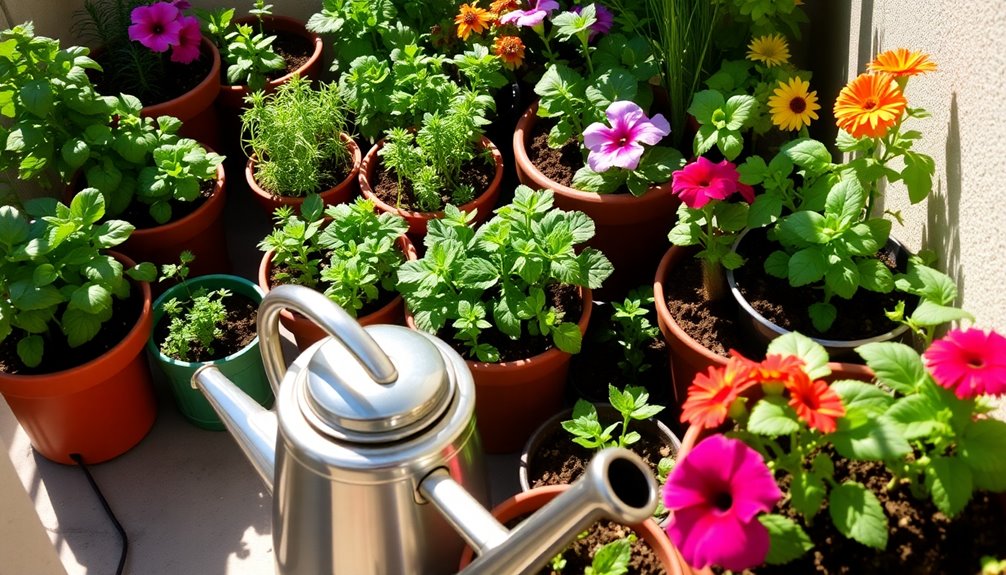
After establishing a solid foundation with the right soil and fertilization, focusing on watering strategies becomes vital for your container garden's health. Container plants often dry out faster than those in the ground, so it's essential to monitor moisture levels regularly. Here are some effective watering strategies you can adopt:
| Strategy | Description |
|---|---|
| Deep Watering | Water thoroughly until it drains from the bottom. This encourages deep root growth. |
| Consistent Schedule | Set a routine, watering at the same time each day or week to maintain moisture levels. |
| Mulching | Apply a layer of mulch on top of the soil to reduce evaporation and keep roots cooler. |
| Drainage Check | Ensure your containers have drainage holes to prevent root rot and overwatering. |
Using these strategies can help you maintain healthy plants, even in limited spaces. Remember to adjust your watering frequency based on weather conditions, as heat and wind can dry out your containers more quickly. By staying attentive to your plants' needs, you'll set your container garden up for success.
Seasonal Considerations for Growth
Understanding seasonal considerations is crucial for maximizing growth in your container garden. Each season brings unique challenges and opportunities that can influence the success of your plants.
In spring, the warming temperatures signal the perfect time to start sowing seeds or transplanting seedlings. Choose varieties known for thriving in warmer weather, such as tomatoes or peppers, to take full advantage of the growing season.
As summer rolls in, monitor your containers closely. High temperatures can lead to rapid drying, so adjust your watering schedule accordingly. You might also consider using mulch to retain moisture and keep roots cool.
In late summer, start thinking about fall crops. Cool-weather vegetables like kale and radishes can flourish as temperatures drop.
When autumn arrives, it's time to prepare for frost. You might want to cover your containers or bring them indoors to protect tender plants.
If you live in a warmer climate, this could also be a great time to start winter gardening with hardy varieties.
Creative Container Ideas
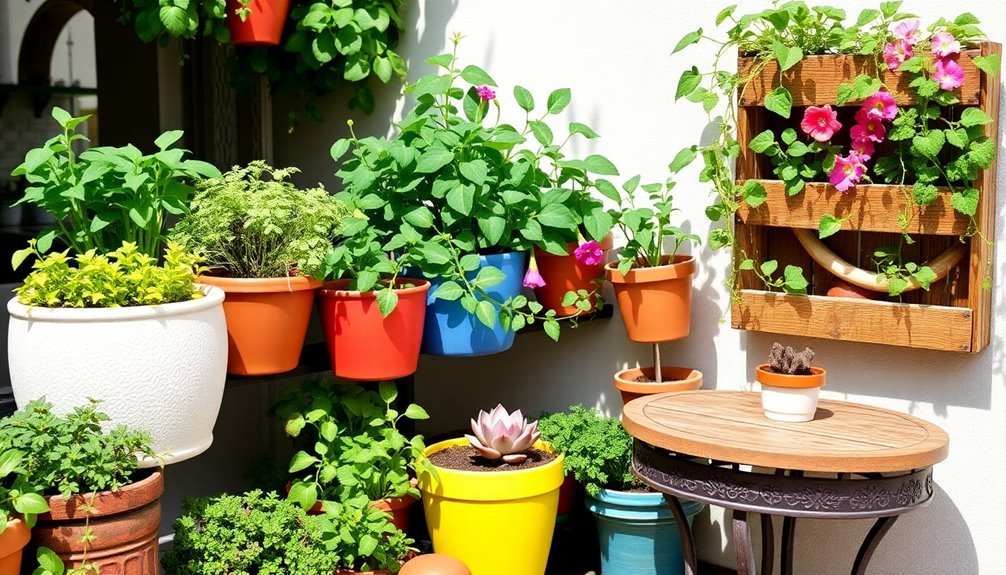
Elevate your container garden with creative ideas that not only showcase your plants but also enhance your living space. You can transform everyday items into unique planters, making your garden both functional and visually appealing.
Here are some creative container ideas to inspire you:
| Container Type | Description | Ideal Plants |
|---|---|---|
| Wooden Crates | Rustic look, great for herbs | Basil, Thyme, Mint |
| Old Shoes | Quirky and fun, perfect for small blooms | Succulents, Pansies |
| Hanging Baskets | Save floor space, adds vertical interest | Ferns, Strawflowers |
| Teacups | Charming mini planters, perfect for small spaces | Cacti, Small flowers |
Don't limit yourself to traditional pots. Use what you have, like tin cans, buckets, or even old furniture. Each of these ideas not only adds character to your space but also reflects your personality. By thinking outside the box, you can create a vibrant and diverse container garden that thrives in your limited area. So go ahead and get creative!
Pest Management in Small Spaces
Creative container gardening can bring life to your limited space, but it also attracts unwanted pests. You don't want those pesky insects munching on your plants or spreading diseases. The good news is that managing pests in small spaces is both achievable and effective.
Start by choosing pest-resistant plant varieties. Some plants naturally deter pests, making your container garden less appealing to them. Incorporate companion planting, where you pair plants that benefit each other, helping to ward off harmful insects.
Regularly inspect your plants for early signs of infestation. If you spot any pests, act quickly! Handpicking larger insects or using a strong stream of water can dislodge them. You can also create homemade sprays using natural ingredients like garlic or neem oil, safe for your plants and the environment.
Encourage beneficial insects, like ladybugs and lacewings, which prey on harmful pests. You might even consider adding physical barriers, such as row covers or mesh, to protect your plants without taking up much space.
Maximizing Sunlight Exposure
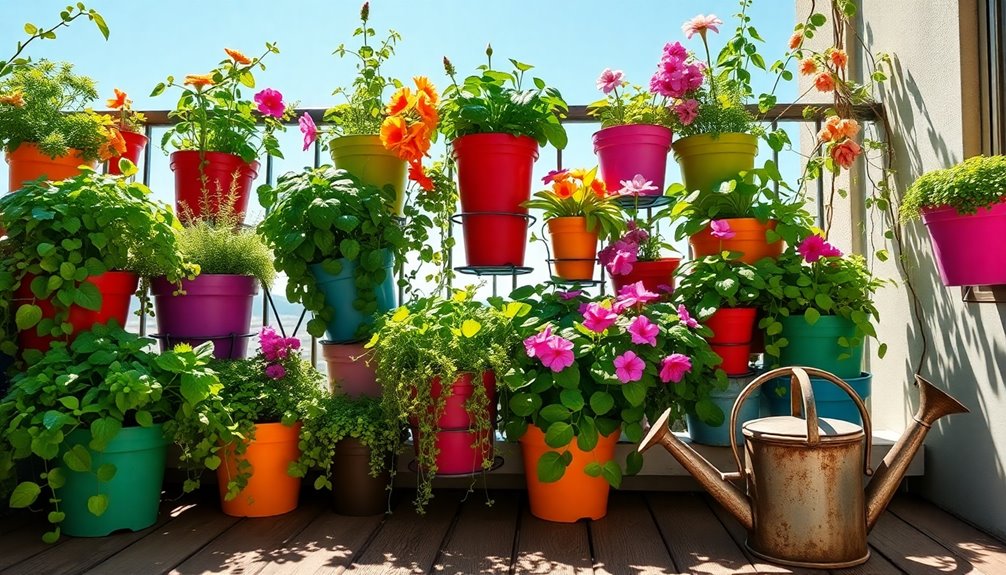
How can you ensure your container garden gets the most sunlight possible? Start by choosing the right location. Find a spot that receives at least six to eight hours of direct sunlight daily.
Observe your space throughout the day to identify areas that get the best light, especially during peak sunlight hours.
Next, consider the height of your plants. Taller plants should be positioned at the back or center of your container arrangement, ensuring they don't block sunlight from reaching shorter plants.
You can also rotate your containers regularly. By turning them every few days, you allow all sides of the plants to soak up the sun evenly, promoting healthy growth.
Utilizing reflective surfaces can also enhance sunlight exposure. If possible, place your containers near walls or fences that reflect light, giving your plants an extra boost.
Additionally, using lighter-colored pots can help reflect sunlight rather than absorb it, benefiting your plants.
Lastly, consider the type of plants you choose. Some varieties thrive in partial shade, so select those that suit your specific sunlight conditions.
Sustainable Practices in Container Gardening
Sustainable practices in container gardening not only benefit the environment but also enhance your gardening experience. By using organic soil and fertilizers, you can nourish your plants without harmful chemicals. Look for compost or natural amendments; this adds nutrients while reducing waste.
Consider repurposing containers, too. Old buckets, crates, or even tin cans can make great homes for your plants. This reduces plastic waste and gives your garden a unique touch.
Water conservation is crucial, so use drip irrigation or self-watering systems to ensure your plants get what they need without excess runoff. Collect rainwater in barrels to further decrease your environmental footprint.
Additionally, grow plants that attract pollinators, like bees and butterflies. This not only helps the ecosystem but also improves your garden's productivity.
Lastly, practice crop rotation by switching out the types of plants you grow each season. This helps maintain soil health and reduces pest infestations.
Frequently Asked Questions
Can I Use Any Container for Gardening?
You can use various containers for gardening, but ensure they have drainage holes. Avoid toxic materials, and opt for sizes that suit your plants' needs. Repurposed items work too, as long as they're safe.
How Do I Prevent Container Plants From Drying Out?
Preventing container plants from drying out is like shielding a flame from the wind. You can use mulch, water regularly, and place them in partial shade to maintain moisture and keep your plants thriving.
What Are the Costs Associated With Container Gardening?
Container gardening costs can vary. You'll need to budget for pots, soil, plants, and possibly fertilizers. Initial expenses might seem high, but they often pay off with beautiful, thriving plants in limited spaces.
Can Container Gardening Be Done Indoors?
Yes, you can definitely do container gardening indoors! Choose the right plants, ensure adequate light, and maintain proper watering. With a little creativity, your indoor space can flourish with beautiful greenery and fresh herbs.
How Do I Choose the Right Size Container?
Choosing the right size container's like finding the perfect pair of shoes; it should fit comfortably. Consider your plant's growth, root space, and drainage needs. A larger pot promotes healthy growth, while smaller ones suit compact plants.
Conclusion
Container gardening transforms your limited space into a vibrant oasis, bursting with life and color. You've learned how to choose the right plants, optimize your space, and maintain your garden with effective watering and soil techniques. By embracing these strategies, you're not just cultivating plants; you're nurturing a thriving ecosystem right at your doorstep. So grab your pots and let your creativity bloom—your little patch of paradise awaits!


